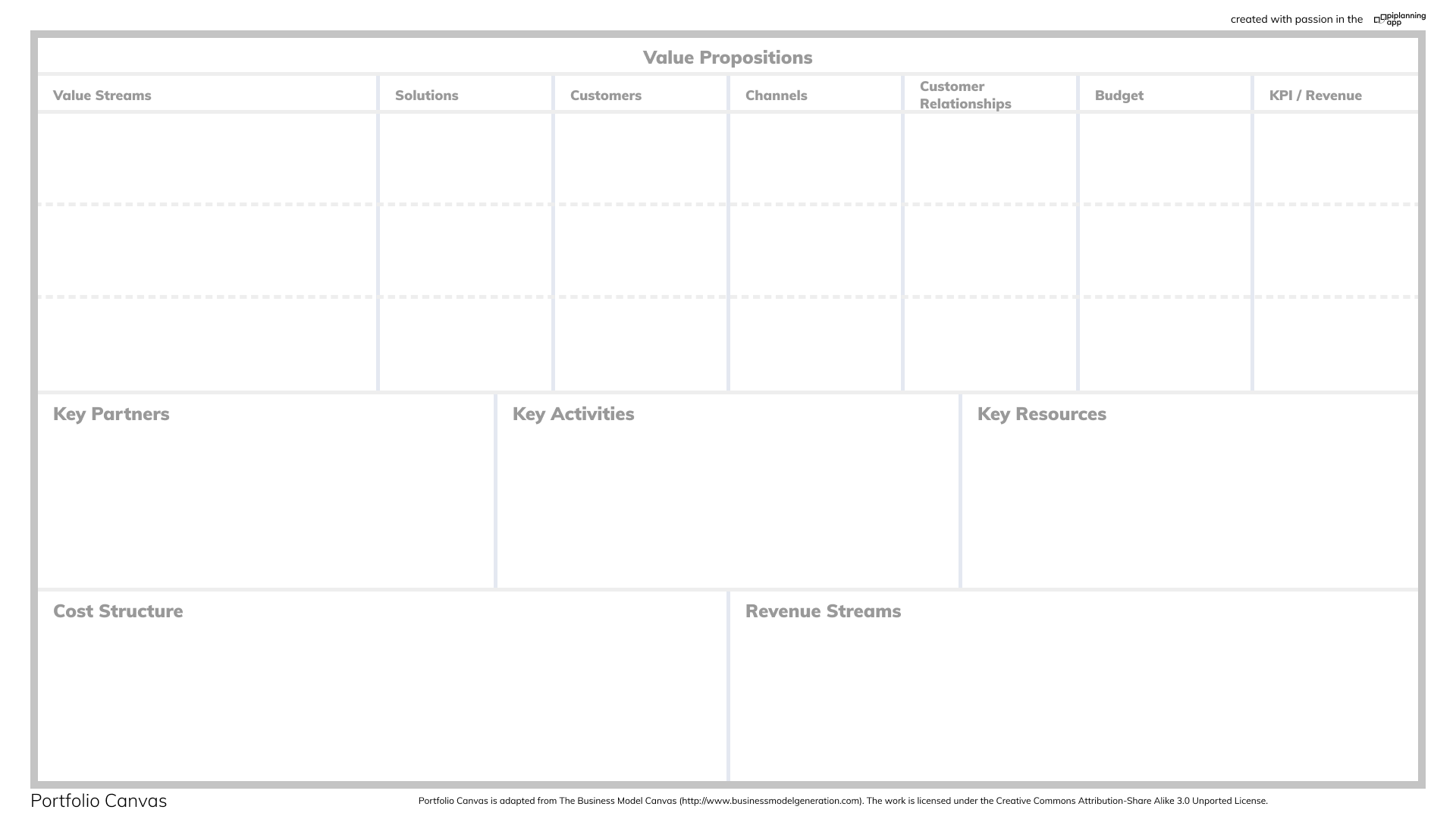Portfolio Canvas
The Portfolio Canvas is designed and provided by Scaled Agile, Inc. and is based on the Business Model Canvas developed by Alexander Osterwalder (Business Model Generation).
The Portfolio Canvas defines the value streams that are included in a Portfolio, the value propositions and the solutions they deliver, the customers they serve, the budgets allocated to each value stream, and other key activities and events required to achieve the portfolio vision. Value Streams are identified in Value Stream Identification Workshops and often described in detail on a Value Stream Canvas.
Value Propositions
The value propositions describe the customers and the value delivered by the solutions of each value stream, as well as the customer segments and relationships, budget and KPIs /revenue. Use a separate row for each development value stream.
- Value Streams: The development value streams that are used to build the systems and capabilities that enable business processes in operational value streams or provide products and services to the operational value streams.
- Solutions: Each value stream produces one or more solutions, which are the products, services, or systems delivered to the Customer, whether internal or external to the Enterprise
- Customers: Customers describe the internal or external customers for each value stream. It defines how the business views and treats various sets of customers differently based on their common attributes.
- Channels: Explains how the enterprise delivers its products and services to intermediaries, customers, and end-users. If serving external customers, this may include marketing and sales mechanisms used to reach customers (e.g., web, direct sales, brick and mortar store, distribution network). If serving internal customers, it captures the interfaces with internal stakeholders and end-users (e.g., internal websites or custom IT applications).
- Customer Relationships: The types of relationships needed with customers to effectively apply and leverage the business’ products and services. It describes the connections and communications with each customer segment. These relationships influence the design of solutions and the allocation of resources within the portfolio.
- Budget: Each value stream is assigned a Lean Budget, which includes operating, overhead and capital expenses.
- KPIs / Revenue: Key Performance Indicators (KPIs) define the measures that will be used to evaluate the results of the value stream investment.
Resources and Activities
The resources and activities describe the key partners, activities and other resources needed to achieve the value propositions.
- Key Partners: The various buyer-supplier relationships and business alliances that facilitate achieving the value proposition.
- Key Activities: The most important actions the enterprise takes to deliver its products and services.
- Key Resources: The critical physical, intellectual, financial, human, and other capabilities and assets the enterprise has to achieve its objectives.
Cost Structure and Revenue Streams
The cost structure and revenue streams describe how the portfolio’s costs are structured and define how revenue or value is achieved.
- Cost Structure: Identify the most significant costs in the portfolio’s business model, including the structural aspects, such as license costs, development labs, hardware, firmware, needed machines, infrastructure and costs of external services.
- Revenue Streams: Describe types and sources of revenue from customers and note the major sources of revenue and how the customer is charged (fixed price, usage-based, etc.). For internal customers, non-profits, and government agencies describe the value of the solutions.
For more information please visit https://www.scaledagileframework.com/portfolio-vision/
